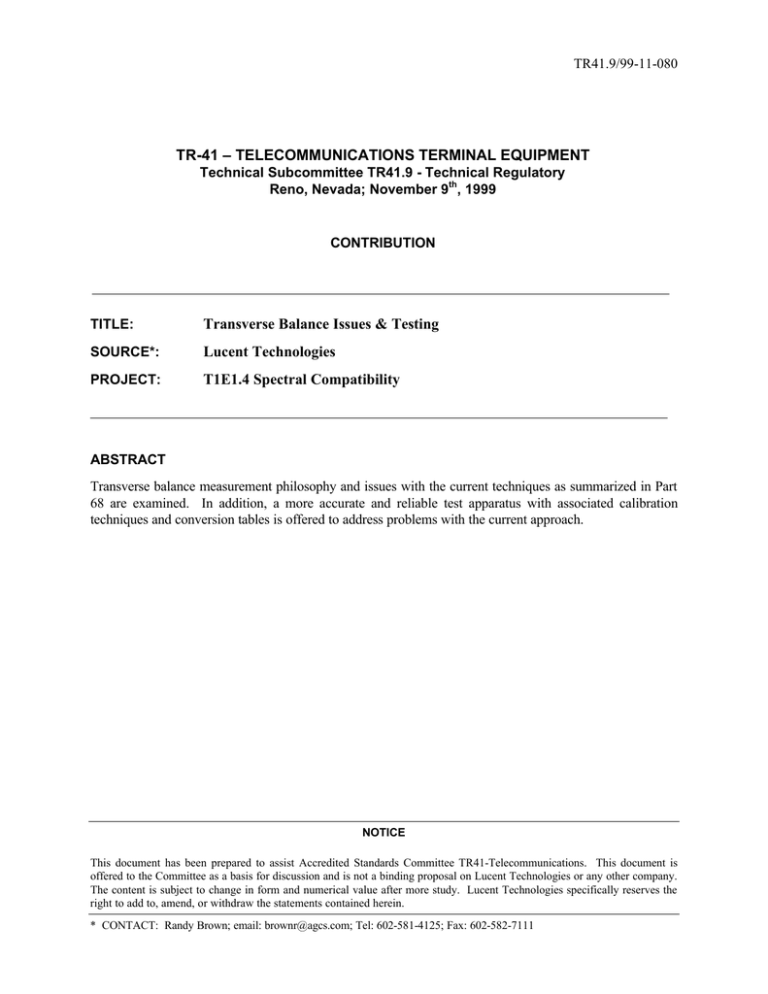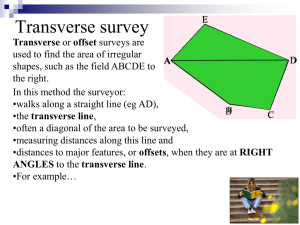T1E1
advertisement

TR41.9/99-11-080 TR-41 – TELECOMMUNICATIONS TERMINAL EQUIPMENT Technical Subcommittee TR41.9 - Technical Regulatory Reno, Nevada; November 9th, 1999 CONTRIBUTION TITLE: Transverse Balance Issues & Testing SOURCE*: Lucent Technologies PROJECT: T1E1.4 Spectral Compatibility ABSTRACT Transverse balance measurement philosophy and issues with the current techniques as summarized in Part 68 are examined. In addition, a more accurate and reliable test apparatus with associated calibration techniques and conversion tables is offered to address problems with the current approach. NOTICE This document has been prepared to assist Accredited Standards Committee TR41-Telecommunications. This document is offered to the Committee as a basis for discussion and is not a binding proposal on Lucent Technologies or any other company. The content is subject to change in form and numerical value after more study. Lucent Technologies specifically reserves the right to add to, amend, or withdraw the statements contained herein. * CONTACT: Randy Brown; email: brownr@agcs.com; Tel: 602-581-4125; Fax: 602-582-7111 Transverse Balance Issues & Testing TR41.9 1 Introduction Transverse Balance is defined in FCC Part 681 as 20log(eM/eL). This coefficient represents the ratio of the metallic eM to longitudinal eL voltage in a tip ring circuit expressed in dB. Longitudinal currents arise from power influence through outside sources, such as AC induced voltage. These currents always exist on the loop to some extent. Longitudinal balance, often considered the balance of the loop itself, is typically calculated from measured values of circuit noise and power influence2: Circuit Balance (dB) = Power Influence (dBrnC) - Circuit Noise (dBrnC) In contrast, Transverse balance measures the conversion of metallic currents in terminal equipment to longitudinal currents that could be injected into the loop and disturb adjacent circuits. 2 Part 68 & Spectrum Management Test Apparatus An "illustrative test circuit," 63.310-1(b), for digital transverse balance conformance testing, as it currently appears in Part 68, is shown below in Figure 1. This circuit is promoted for testing digital circuits with bandwidth extending from voice range through 1.5444 Mbps. There are several issues with in this diagram: 1. Resistor R1 has not been included. 2. Note 3 provides no reference to R1. 3. R2, the longitudinal termination, is not identified. 4. RCAL, the resistor connected by S1, is not identified. 5. It's not necessary to use a spectrum analyzer or selective voltmeter to measure the metallic voltage; the level is high enough to use any high impedance voltmeter with adequate frequency response. 6. To measure the voltage across R2, a selective device is generally required; however, R2 is grounded, and therefore the device need not be balanced. 7. Given the differential capacitor the 3pF capacitor seems unnecessary. Lucent Technologies Page 2 02/08/00 Transverse Balance Issues & Testing TR41.9 Part 68 Transverse Balance Test Apparatus Figure 1 3 Proposed Transverse Balance Test Apparatus This attempt for improvement is consistent with the guidelines of Part 68 on transverse apparatus 5: …other means may be used to determine the transverse balance coefficient specified herein, provided that adequate documentation of the appropriateness, precision and accuracy of the alternative means is provided by the applicant. Lucent Technologies Page 3 02/08/00 Transverse Balance Issues & Testing TR41.9 Design of test apparatus to measure transverse balance should take into account an appropriate figure of merit. The current instantiations in Part 68 rely on voltage measurements; however, as frequency increases, parasitic elements, such as capacitors and resistors, can affect the measurement. Consequently, the notion of simple extrapolation of the present Part 68 transverse balance test apparatus to higher frequencies using linear thresholds is flawed. Conversely, in return loss testing, the limiting case is part of the calibration. That is, the worst possible termination lies somewhere between a short and open. Subsequent measurements are then used to determine how well the device performs relative to the worst case. Success is defined when it differs by some performance (20 dB of effective return loss) at normal impedance versus the extreme. An alternate approach is to devise a current model, measuring tip and ring magnetic flux, to minimize disruption to the test configuration by outside elements and create a test apparatus with more precision and greater repeatability. Such a model is proposed in Figure 2. Transverse Balance Test Apparatus Transverse i i Balance = 20log 1 + 2 i 1-i 2 Z = 135Ω Ω Metallic Current 1:1 i1 S2 135 / 4Ω Ω b c a TIP C1 < 30 pF i 1- i 2 i 1+ i 2 S1 135Ω Ω Center Tap 85Ω Ω 90 Ω RL C2 L1 L2 M EUT RING a c S2 i2 Generator (Network Analyzer) T1 Metallic Current Same Unit High Z Network Analyzer b (open) L1 and L2 are equivalent • Current measuring modem rather than a voltage measuring model • Depending on orientation of L1 and L2, metallic current cancels and longitudinal current sums • Absence of longitudinal coupling indicates a better transverse balance Figure 2 Here, two variable capacitors C1 and C2 balance the residual impurities of the 2 windings of T1. Parasitic effects of components in the circuit when equal and opposite will cancel. As such, no calibration is required and the resulting low impedance signal measured is more sensitive than the EUT. The Lucent Technologies Page 4 02/08/00 Transverse Balance Issues & Testing TR41.9 measurement method achieves the basic goal of quantifying lost current that doesn't flow equally through tip and ring across the frequency of interest. 4 Conversion of Results to Voltage Ratio Since the test circuit excitation voltage, VM; and longitudinal termination impedance, ZLT (RLT) are the same as those used as in the voltage ratio tests required by FCC Part 68 Rules, the current ratio measurement results from the proposed new method may be readily converted to equivalent FCC results. In Figure 2, the current measured by the right hand toroidal current sensor, denoted i1 + i2, is in fact twice the metallic current, IM. Similarly, the current measured by the left-hand sensor, denoted i1 – i2, is exactly the longitudinal current, IL. Clearly, we can express the voltage ratio, called VRATIO below, as: VRATIO = IM ZM IL ZL = IM ZM I L RLT = VM Equation 1 VL Equation 1 can be written: Z VRATIO = M RLT I M I L ZM = R LT IRATIO 1 Z M = 2 2 RLT IRATIO Equation 2 Where IRATIO is the ratio measured by the test apparatus and used in the Transverse Balance equation of Figure 2. In other words, the FCC voltage ratio is obtained (before taking the log) simply by multiplying the current ratio by 1/2 the ratio of the magnitude of the DUT’s metallic impedance to the value of RL. RL fixed, real, and known, and the magnitude of ZM is either known or easily measurable, and will often be nearly constant over the frequency band of interest. Equation 2 is expressed in logarithmic form: Z VRATIOdB = 20 Log M RLT − 6.02dB + 20 Log ( IRATIO) Equation 3 The first term in Equation 3 is the necessary correction factor. For ZM = 135 Ω and RL = 90 Ω, the factor is –2.50 dB; for ZM = 100 Ω and RL = 90 Ω, it is –5.10 dB. Equations 2 and 3 hold, even if the DUT is a non-linear or active device, so long as we excite the DUT with the same metallic voltage, and use the same longitudinal termination resistance in the test apparatus as are specified for the equivalent FCC Part 68 tests. Lucent Technologies Page 5 02/08/00 Transverse Balance Issues & Testing TR41.9 5 Calibration of High Frequency Transverse Balance Test Apparatus Note S2 in figure 2 represents a two pole switch box that sets the tip and ring connections to either "a," or "b" as shown above. "a" creates a circuit with 135 ohms resistance simulating the equipment under test (EUT) and as such is a "perfect termination" case. "b" has one side grounded and the other open. This represents the worst case. S1 is a two pole switch box that reverses the connections for tip and ring. 1. Remove EUT from the Tip/Ring pair and terminate the Tip/Ring pair with 135 ohms (S2 to "a"). This represents a "perfect termination" case. 2. Adjust the tracking generator voltage to measure -10dBV (316mVrms) across the Tip/Ring pair. 3. Adjust C1 and C2 to obtain maximum transverse balance. Note that transverse balance shall be defined as follows: Transverse Balance = 20log|(i1+i2)/(i1-i2)|. The result of this balance calibration shall be at least 20dB better than the requirement for the applicable frequency band. 4. Reverse the polarity of the Tip/Ring pair at S1. If the transverse balance changes by more than 1dB, the test circuit needs further adjustment to improve its measurement accuracy. 5. Terminate the Tip connection with 33.75-ohm resistor and the Ring connection to ground (S2 to "b"). Verify that the transverse balance measurement is less than 1dB. Reverse the polarity of the Tip/Ring pair at S1. Again, verify that the transverse balance measurement is less than 1dB. If both conditions are not met, the test circuit needs further adjustment to improve its measurement accuracy. 6 Conclusion A better mechanism for measuring transverse balance has been presented that is simpler, more accurate and can extend to frequencies spectral classes of DSL require. This apparatus should be considered as a standard apparatus used in transverse balance test procedures. Lucent Technologies Page 6 02/08/00 Transverse Balance Issues & Testing TR41.9 Annex A - Calibration Examples Short to 135 Ohms Open 0 dB 60 dB Passing Device 40 dB Lucent Technologies Page 7 02/08/00 Transverse Balance Issues & Testing TR41.9 Annex B - Reference DSL Test Circuit Simulated Line Circuit RT 450Ω Ω RR 450Ω Ω EUT . . . . . . PTC* POTS Filter . . . . POTS Filter * Positive Temperature Coefficient Resister Lucent Technologies Page 8 02/08/00 Transverse Balance Issues & Testing TR41.9 References [1] Federal Communications Commission Rules and Regulations, Code of Federal Regulations Title 47: Part 68 - Connection of Telephone Equipment To The Network. Section § 68.310, pg. 315 [2] Subscriber Loop Signaling and Transmission Handbook, Reeve, 1992, IEEE Press [3] T1E1.4/99-356, "Proposed Text for Transverse Balance Requirements in dpANS for Spectrum Management", Bell Atlantic, June 7-11, Ottawa, Ontario, Canada; [4] Federal Communications Commission Rules and Regulations, Code of Federal Regulations Title 47: Part 68 - Connection of Telephone Equipment To The Network. Section § 68.310, pg. 305 [5] Federal Communications Commission Rules and Regulations, Code of Federal Regulations Title 47: Part 68 - Connection of Telephone Equipment To The Network. Section § 68.310, pg. 315 Lucent Technologies Page 9 02/08/00
